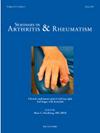Weight loss, disease activity, and patient reported outcomes in patients with musculoskeletal and autoimmune diseases taking weight loss medications: a retrospective cohort study
IF 4.4
2区 医学
Q1 RHEUMATOLOGY
引用次数: 0
Abstract
Introduction
Given potential impacts of adiposity on pain and inflammation, we evaluated if weight loss was associated with improvements in disease activity and patient reported outcomes (PROs) in people with rheumatic and musculoskeletal disease (RMD) using weight loss therapies.
Methods
Participants with RMDs enrolled in the FORWARD Databank and reporting weight loss medication use were included in this retrospective cohort study. Linear models using generalized estimating equations assessed the association with ≥5 % weight loss and changes in PROs and disease activity over a 6-month period, clustering by participant and adjusting for the prior 6-month PRO, BMI, diabetes status, age, and sex. Testing for effect modification was performed to assess whether the effect of weight loss varied across BMI categories and across condition.
Results
We identified 3868 users of weight loss medications with 24,484 discrete observations. Weight loss ≥5 % was reported in 10.5 % (2603) of observations and was associated with improvements in patient activity scale II (PAS-II), patient global assessment, pain, fatigue, polysymptomatic distress, and SF-36 physical component score (PAS-II adjusted: B -0.12, 95 % CI -0.17, -0.067, p < 0.001). Those who lost ≥5 % of weight were more likely to have improvements in PAS-II and PROs if they were obese, independent of diagnosis.
Conclusion
Among participants with RMDs that reported weight loss medication use, ≥5 % weight loss was associated with statistically significant improvements in patient-reported disease activity and quality of life PROs. The use of weight loss medications could be considered in trials aimed at improving symptoms of RMDs.

服用减肥药的肌肉骨骼和自身免疫性疾病患者的体重减轻、疾病活动度和患者报告的结果:一项回顾性队列研究
考虑到肥胖对疼痛和炎症的潜在影响,我们评估了在患有风湿性和肌肉骨骼疾病(RMD)的患者中,使用减肥疗法减肥是否与疾病活动度的改善和患者报告的结果(PROs)相关。方法在FORWARD数据库中登记并报告使用减肥药的rmd患者纳入本回顾性队列研究。使用广义估计方程的线性模型评估了6个月期间体重减轻≥5%、PRO变化和疾病活动的相关性,按参与者聚类并调整了前6个月PRO、BMI、糖尿病状态、年龄和性别。对效果修改进行测试,以评估减肥的效果是否在不同的BMI类别和不同的情况下有所不同。结果通过24,484个离散观察,我们确定了3868名减肥药使用者。10.5%(2603例)的观察报告体重减轻≥5%,并与患者活动量表II (PAS-II)、患者整体评估、疼痛、疲劳、多症状窘迫和SF-36身体成分评分(PAS-II调整:B -0.12, 95% CI -0.17, -0.067, p <;0.001)。那些体重减轻≥5%的人,如果他们是肥胖的,独立于诊断,更有可能改善PAS-II和PROs。结论:在报告使用减重药物的rmd患者中,体重减轻≥5%与患者报告的疾病活动度和生活质量的统计学显著改善相关。在旨在改善rmd症状的试验中可以考虑使用减肥药。
本文章由计算机程序翻译,如有差异,请以英文原文为准。
求助全文
约1分钟内获得全文
求助全文
来源期刊
CiteScore
9.20
自引率
4.00%
发文量
176
审稿时长
46 days
期刊介绍:
Seminars in Arthritis and Rheumatism provides access to the highest-quality clinical, therapeutic and translational research about arthritis, rheumatology and musculoskeletal disorders that affect the joints and connective tissue. Each bimonthly issue includes articles giving you the latest diagnostic criteria, consensus statements, systematic reviews and meta-analyses as well as clinical and translational research studies. Read this journal for the latest groundbreaking research and to gain insights from scientists and clinicians on the management and treatment of musculoskeletal and autoimmune rheumatologic diseases. The journal is of interest to rheumatologists, orthopedic surgeons, internal medicine physicians, immunologists and specialists in bone and mineral metabolism.

 求助内容:
求助内容: 应助结果提醒方式:
应助结果提醒方式:


